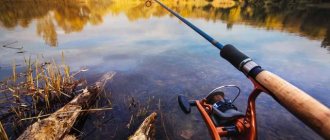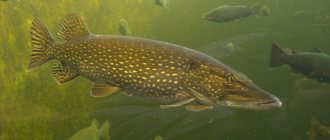February is the end of the winter season. In some places it also covers March, but in central Russia, even in the North and Far East, this month is the last in which it is entirely possible to fish from the ice. Then the ice becomes more fragile, it will be dangerous to go out on it from mid-March, and in the end, even where it will still be completely undesirable.
Burbot spawns in January, approximately in the second half. Its spawning occurs in groups of two fish, a male and a female, in fairly deep-water places. For its spawning grounds, it preferably chooses a sandy or pebble bottom, which is very hard; it can rarely be found on clay, practically does not enter silted areas, and always prefers running water to standing water . In the northern regions and Siberia, its spawning is postponed to the beginning of February.
In February it feeds on small fish, aquatic insects, and worms. Fish and small fish form the basis of its diet, since there are not many insects in the water. Does not stop feeding either during spawning or after it. There is practically no period for burbot when it “leaves” after spawning, stops feeding and moving, and experiences a lack of strength. On the contrary, this slippery type maintains nutritional activity even when spawning.
In the old days, poaching methods of catching burbot, such as bagging, were common. This was due to the fact that for some reason he prefers light stones for spawning. A loaded bagel in the form of a white board with hooks was lowered to the bottom, the fish went to it and sat on its belly. A modern fisherman should avoid such methods, especially since the punishment for them has now become much more severe, and rightly so.
Biting and fishing for burbot
This fish is very similar to pike perch both in habits and in bite, with the difference that pike perch is a schooling fish, and burbot is a solitary fish. Both of them grab the bait that moves in the water column; often burbot, like pike perch, presses the bait with its chin and gets caught “by the beard”, and even more often than the latter; both prefer night hunting to daytime hunting, but are often caught at dusk or at dawn. On a gloomy day with precipitation, burbot, as well as pike perch, can be caught well during the day.
The burbot bite is quite difficult. He grabs the bait, guided by his senses, the lateral line, touching it with his lower whiskers, and also attracted by the smell. Very partial to the smell of fish mucus and fish blood. That is why it is better to catch it with natural bait than with artificial bait. Probably, the ruff is also attractive to him because of some special smell, which is unpleasant for competing fish, roach and silver bream, but for burbot it is a signal of the presence of food.
When hooking, the impression of a hook is created. While playing, he behaves quite stubbornly throughout. It is especially difficult to get it into the hole. Burbot has a strong, long body and will always rest its tail against the edges of the ice. When fishing for it, be sure to use a 130 or 150 mm drill . Weaving will create big problems both when fishing with live bait and when fishing with lures. After the hundredth hole, it will be very difficult to get a burbot weighing more than 700-800 grams, and even without a hook.
The latter, by the way, is a mandatory accessory for a fisherman when fishing. It is not necessary to have a yawner for burbot. It has not too large teeth, which look like a grater in several rows. With their help, he very tenaciously holds the bait, even slippery and nimble ones, but it is quite difficult for him to bite through human skin. When hunting, he grabs the prey “as needed”, often presses it, then takes it into his mouth and immediately begins to chew. Swallows already chewed fish, usually from the head.
When and how to catch burbot in reservoirs?
Depending on the chosen fishing method, burbot is mostly caught from the shoreline. The time for fishing will vary for different methods, but the places are the same.
Spinning
Fishing of the water area is carried out after sunset, but before darkness, so that faint traces of detection can be noticed. Ideal places are shallows with a sandy bottom and shallow depths with small pebbles close to the shore.
Zakidushka
The casting of the tackle is carried out at approximately the same time, and it will remain there until the morning. Usually several rods are used at once, which are cast at different distances relative to the shore. This way you can capture a larger area for fishing, thereby increasing the chances of a trophy specimen.
Feeder
Fishing with a feeder is carried out in the same way as with a cast, only before casting, freshly prepared bait is stuffed into the feeder. Periodically it is necessary to check the presence of food in the feeder and fill it again to attract the attention of the fish.
It is necessary to increase the amount of food when the bites weaken, in this way the burbot’s interest in the bait will increase.
If within an hour after casting the tackle there was not a single bite and the bait on the hooks was not touched, you should change the chosen fishing spot.
Burbot fishing on the Irtysh in the fall is also carried out with vertical spoons, which are most often used for winter fishing. The best option would be jigs, elongated in shape with cut ends. Lure fishing is carried out with onboard rods from a boat, while the equipment is completely identical to the spinning rod, only the rod is taken shorter.
Fishing for burbot does not stop in winter; it is successfully fished in the first ice until mid-December, when the cod fish begin to spawn. Until February, burbot becomes lethargic and almost does not respond to the offered bait.
In the spring, when the air and water temperatures rise, burbot goes to deep holes and does not leave them until mid-autumn.
Burbot is caught only in the cool season; it does not tolerate warm water. To catch a decent option, it is preferable to catch burbot at night; during daylight hours, this predator rests in a secluded place.
Post Views: 160
Tagged time to use fishing better possible Burbot burbot carried out
You might also like
Carp fishing in autumn
15.05.201923.07.2019
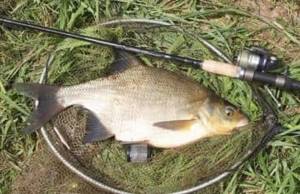
Bream fishing in October
16.05.201923.07.2019
Fishing for pike with live bait in the fall
13.07.201923.07.2019
Add a comment Cancel reply
You must be logged in to post a comment.
Categories
Recreation centers Types of hunting Types of fish Types of fishing Mushrooms silent hunting Wild animals Livestock Hunter's calendar Maps of hunting grounds Horse. Horse Bow and Crossbow Attachments. Bait Our cats News About everything Hunting weapons Hunting dogs Hunting farm Nature conservation Underwater hunting Rules and Laws Poultry farming Birds Plants Hunter's recipes Fishing in spring Fishing in winter Fishing in autumn Fish farming Equipment Snowmobile Dogs Articles Hunting Articles fishing Articles fishing 2 Facts about animals
Recent comments
- KasnamoMit to the post What birds live in the Moscow region and Moscow
- JeremyIdoda on Stuffed geese, fake
- Cecilia on the entry Characteristics of the common flying squirrel (flying squirrel)
- Pablobrita on Stuffed geese, fake
- alex63175 on Stuffed geese, fake
Privacy Policy
Feedback
Information taken from open Internet sources. The administrator is not responsible for information posted by subscribers. Powered by bite and snow.
Selecting a location
As already mentioned, for fishing they choose places with a sandy or pebble bottom that is clear of silt. Burbot prefers white pebbles, apparently this is due to the fact that they are usually limestone and release some compounds of calcium, magnesium, and their salts into the water in large quantities. For the same reason, he is very partial to concrete structures underwater.
The shell is also a tasty food for burbot. Shells reproduce in February-March; burbot, like other aquatic inhabitants, enjoy feasting on budding shells. After mating, they hatch between the valves of the parent shell and practically do not have their own shell, which they then build up. The shell is also a very good place to catch burbot.
Spawning takes a lot of energy from burbot. It tries to occupy places that are close to spawning grounds, and in winter it stays near them. Usually, in order to spawn, it requires the presence of some underwater objects that it can rub against. Burbot is often a sedentary fish, and if it was successfully caught somewhere in October, then most likely it will also bite well in the same place in January and February. Nevertheless, it still makes some movements, most often before spawning in search of a mate, male or female, if they are not found in their permanent habitat.
Victoria Leshchenko
I've been working hard in the fishing tackle department for the past six years. I can help you assemble almost any gear.
Ask a Question
In summer, burbot usually hibernates. To do this, he definitely needs shelter in the form of underwater snags and stones under which he can make a hole. For him, the presence of a current is highly desirable, and even a strong one is more of a plus than a minus. The depth for catching it is usually chosen from one to four to five meters; at smaller or greater depths it can only be caught under certain conditions.
On small rivers the situation is somewhat different . There are not many fish here, but there is much more food in the form of worms that fall into the water from the banks. Even in winter, they sometimes crawl out from under their deep burrows and are carried away by the current. Burbot feed here by moving up and downstream, looking for food under snags. You can catch it on almost any bottom, but it is preferable to choose places near steep ravines, where a lot of soil is washed away by water. Live bait will be a tasty food for him here, but getting it here in winter can be difficult.
Considering the sedentary nature of his life, if somewhere there is a place suitable for spawning next to snags, where there are large stones or concrete structures under which you can burrow into hibernation in the summer, where the river has a hard bottom or a bottom covered with shells - this will be the best place for catching burbot. The fishing depth is from one to four meters, it is caught exclusively from the bottom.
Baits and lures
Fishing for burbot in late autumn involves the use of a variety of baits and lures; experienced fish never settle for fishing with just one species. A variety of baits and lures are used, it all depends on the type of fishing.
Spinning
Fishing for burbot in October with a spinning rod is carried out using oscillating spoons. The cod fish respond best to elongated silver-colored varieties; they imitate a real fish as realistically as possible. The most catchy baits are considered to be “Atom” and “Gering” type spinners; burbot bites well on a castmaster.
The weight of the spinners should be sufficient to fish the bottom layers of the reservoir, so it is better to give preference to heavier options. The most acceptable weight is 10-28 g.
Feeder
The best bait for catching burbot with a feeder is considered to be a worm; in addition, an important point will be the bait in the feeder; without it, fishing will not work out. Catching burbot on a feeder requires the mandatory use of food, but purchased mixtures will not help lure the predator. Fishermen on the Neva and Klyazma use a homemade version, which is prepared right on the shore. To make everything work you will need:
- a small number of small minnows, ruffs or other small fish;
- several worms, which will then be used as bait;
- soil from a pond, preferably with clay and sand.
Fish and worms are cut into small pieces and mixed with soil into a strong lump. The resulting mixture is stuffed into a feeder without a bottom or thrown without it into the place where the hook is located.
Donka
Donka for burbot involves the use of animal bait, most often the capture is carried out with live bait. Fishing for burbot on the Oka in the fall is effective with shrimp, which are pre-boiled. A good option would be worms, bloodworms and maggots, which are unlikely to attract the attention of a cod representative.
Burbot will never rise for the proposed bait in the water, so the retrieval of the spinners proceeds slowly, without sudden jerks.
Catching burbot in February with a spoon
Spinner is a common bait for most winter anglers. It will be the best choice for those who have never caught burbot before, but know how to use this gear.
Lures for catching burbot using a spinner
For fishing, a fairly heavy oval spoon is traditionally used, which is a simple body without any bends. The hook is soldered, with a long reach. It is customary to attach a ruff head or tail, a worm, or a strip of meat from the same burbot to the hook. Tees and hanging hooks are rarely used, since it is impossible to fish with them “by knocking”, they will scratch along the bottom, burbot does not really like this. You can make such a lure only from a hook with a long shank, separate from the eye.
In the current, it gives a stable, almost nail-like game, deviating slightly due to the current and then returning, slightly playing along. Some spoons, despite the lack of bends and symmetry of the body, have much greater catchability than others. This is due to the shape of their body.
The body of the spinner is made of tin. This metal, even under water, has a dull white color, which will be attractive to burbot. You should not solder it onto the nickelselbur, especially if you plan to leave it smooth. Bright metal plates will scare away fish; it is important to keep the color matte, even and light. In addition, tin has a more suitable density and promotes good play than lead or lead heavy solder.
In my opinion, a bottom spinner should be catchy. This bait was described by Dmitry Shcherbakov in one of his videos. Often, lure fishing is accompanied by a characteristic knocking sound that attracts burbot. You can also try fishing with so-called “phantomas”, other baits that are a type of bottom spinners, but easier to manufacture. The bait should have a whitish matte color.
Tackle for catching burbot with a spinner
For fishing, any rod with a length of 50-60 cm can be used. When playing with a spinner, it happens that the fish takes only by knocking on the bottom, or by knocking on the ice from below, or by tossing from the bottom, or by playing with the rod lowered down, or on a standing horizontally, or standing at a certain angle downward, or for trembling. All this needs to be calculated and your style of play determined. As a rule, one rod is suitable for one spinner, since usually its action will be unique and it is made independently. Therefore, it is important to have a choice of at least five rods.
The fishing line used is medium, 0.2-0.25 mm. Burbot has a stubborn resistance and you need to be able to withstand it well. For the current and proper play, the spinners select the fishing line individually; as a rule, the stronger the current, the thinner the fishing line. Also, the thickness of the fishing line depends on the additive on the hook; the larger it is, the thinner the fishing line is taken. And also on the depth of fishing - the deeper, the greater the chance of a bite with a thin line and the less with a thick one.
Braided cord is not taken so often; it is usually fished in the dark, where the cord often gets tangled, since it is softer than fishing line. But choosing a black fishing line is a great idea. Usually this is produced for feeder or carp fishing. The black line will be clearly visible on white snow and ice, and there is less chance that it will get tangled.
Of course, all fishing rods should have a comfortable handle and be equipped with a reel. It is best to use a good winter multiplier, with which you can easily both pull out the fish and quickly reel in and reel in the fishing line.
Techniques for catching burbot using a spoon in February
Typically, fishing comes down to actively searching for fish and constantly fishing for already drilled holes. Burbot is not a particularly schooling fish, and catching two dozen from one hole is rare. However, taking off three or four pieces is common. The fact is that there is such a thing as fish release, as when fishing for pike. It happens that in approximately one place the burbot begins a hunt, which lasts about 15 minutes. Therefore, if there were bites, it’s worth drilling out this place and then returning to it after some time. You should not sit on a hole where there is no bite with a spoon for more than five minutes. For those who do not like to walk from place to place, there is another tackle - a snitch.
Catching Burbot in Winter on Donka
Construction of Winter Donoks:
— We calculate the depth at the fishing spot, the size of the fishing line is equal to the depth plus another 3-4 meters. Line diameter - no less than 0.4; — Bait: either small live fish or cut pieces of meat. You can put two hooks to diversify the bait; — Donks with bait are lowered to the very bottom, the line should sag slightly. Sticks are placed across the holes, to which fishing lines are tied; — Donks are usually installed in the late afternoon and checked in the morning.
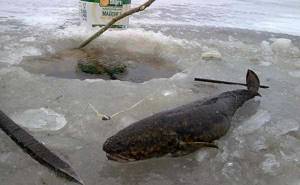
If the place is crowded, the places where the donks are installed should be covered with snow, making marks that are visible only to yourself. In severe frosts, the holes freeze very much, and in the morning you have to work hard with an ice pick to get the fishing line. Often the fishing line is damaged when the hole is cleared of ice.
You can tie a piece of copper wire to a stick instead of a fishing line, and then a fishing line to it. You can cut another hole nearby and pull it out with a wire hook. In this article we also attach a video; it is better to see once than to hear a hundred times.
Burbot on Donku in Winter (Video)
Catching burbot in February with a snitch
The squealer is an old and original tackle for catching burbot. It looks like a jig head, only larger, sometimes with a flat bottom to make it easier to hit the bottom. A bait is placed on the hook - a dead fish, a fish tail, a bunch of worms, lard. In some places, on Msta, on Mologa, lard is the best bait for burbot when fishing with bait.
The bait must be fresh; you should not catch any fish with any rotten stuff. Contrary to popular belief, any fish avoids spoiled food, including burbot and even rotan.
Usually, burbot approaches the sound when it moves from its daytime stopping place to its night feeding areas and back. The bite usually occurs by the beard; he rarely takes the bait into his mouth.
Tackle for catching burbot using a snitch
Traditionally, fishing tackle is a regular stick with a reel and a pinch for fishing line at the end, about 50 cm long. Modern fishermen can use a rod with a reel. It is imperative to use a rigid fishing rod, since the fishing rod itself has significant weight, and the game must be rigid and rhythmic. Most often, they are caught with not one, but two little pieces, pulling them alternately with the left and right hand. Otherwise, the fishing rod is very similar to the one used for sitting lure fishing, only more rigid.
The weight of the piece should be at least 30-40 grams; 50 grams are more often used. It is attached to a fishing line with a diameter of 0.2-0.25 mm, it is convenient to use the fastening through a clasp and a swivel, so that if something happens it can be quickly changed. Since fishing for burbot takes place in the current, most often the weight of the fish depends on the strength of the current. The most commonly used doll is in the form of a bullet, when it is flat at the bottom and has an oval top. A large hook with a long shank is soldered into the side, and in the center of the body there is an eyelet for fastening.
Bait for catching burbot using a snitch
The bait usually used is a whole fish, a tail or a head. It is not necessary to use live fish; dead fish will do. The hook is passed through the mouth and out through the back, threading it with a stocking. Often burbot likes to peck at lard, and the kind that “flows”, that is, taken closer to the meat and more tender. You can also catch worms using a bunch of worms, but they must still be alive. A very good bait is raw beef liver, and let it bleed in the water. Any attachments such as chicken skin and giblets are rarely used; apparently, burbot does not really like their “chicken” smell. It is advisable not to experiment with attachments, but to use already proven ones.
Technique for catching burbot using a snitch
Burbot, although a sedentary fish, makes some movements during the day. At the intended location of such movements, the fisherman sets up a tent in the evening and stores firewood for the night. On a small river you can put up a tent almost anywhere where the bottom is good; the burbot walks along here and is unlikely to pass by the small fish, since the width of the river is small.
For fishing, you need to choose places with a fairly hard bottom. On the sandy bottom they knock somewhat more often, on the rocky bottom - less often. The fishing technique is quite simple. The small piece is placed on the bottom, the fishing line is installed so that its length is just enough to stretch to the bottom. Make periodic throws with the rod up and back so that the tackle hits the bottom.
At first they make a few quick blows, then they begin to knock rhythmically and slowly. Burbot hears the blows from afar, approaches and pecks at the bait, which he hears by smell and sees. Usually there is no need to drill many holes, since this does not change the chance of a bite. The sound attracts fish from a long distance, similar to bait.
Tackle for catching burbot
In order to return with a good catch, it is also necessary to choose the right gear for catching this prey.
There is nothing complicated in this process; it is enough to follow the following tips regarding the choice being made:
- The fishing line is suitable for any type and from any material, the only condition is its ability to withstand a tensile strength of at least 5-6 kg. Despite the fact that burbot rarely resists the fisherman when fishing, it can be quite problematic to pull it out of the shelter in which it loves to hide.
- of leashes is recommended . The most preferred material is nylon or steel; the thickness should be at least 0.5-0.6 mm, since a thinner version will easily be ground or bitten by teeth.
- In winter, burbot is most often caught on burbot tees.
Tees for burbot are not used, so the hooks should be single; models from No. 9 to No. 13 are best suited, depending on the size of the intended catch. - The sinker used must be flat and able to slide freely along the line. Its weight is determined already at the fishing spot, since this parameter depends on the fishing conditions, as well as on the current in a particular body of water.
- The choice of rod depends on the fishing conditions and time of year. In the summer you can experiment and try different options, including float rods. Spinning fishing is usually common in the spring or autumn, and in winter it is recommended to use exclusively girders.
Catching burbot in February using girders
Fishing for burbot using a girder in February will be the best way. The fact is that the nights are usually very cold, and you don’t want to spend them on the ice. If you do happen to spend the night, it is better to spend this time in a warm tent with a heater. The zherlitsa allows you to fish in the absence of the angler, who is entrusted only with the task of catching live bait and choosing a place for the gear.
| tackle component | required characteristics |
| fishing line | diameter of at least 0.4 mm, each vent must be at least 15 m |
| leash | the best option would be metal |
| hook | use single or double live bait options |
| sinker | weight depends on the depths fished, 10-15 g will be quite enough |
| live bait | It is best to use a small brush |
Tackle for catching burbot on girders
The old way of catching this fish is catching. The underpass was a large pole that was stuck through the hole into the bottom. A leash was attached to it at the bottom, on which a hook with live bait was placed. They put him in overnight and then went to check him in the morning. The pole is convenient because you can use it, even without a pick, to turn the crust of ice and pull the fish up, without really worrying about how well it fits into the hole. In addition, a pole sticking out above the ice could be noticed from afar and found even if there was a snowstorm at night.
Modern fishermen use the same gear for catching burbot as for pike. Zherlitsy are usually taken with a reel and a flag. It is advisable to spot the burbot, since it may well, having felt the fishing line or hook, spit out the fish. However, given the nighttime nature of fishing, as well as the fact that the girders are placed at a considerable distance, you have to rely on the fish hooking itself.
As a result, only approximately every third or fourth burbot is detected. If you still want more active fishing and greater productivity, you can try equipping the girders with an electronic signaling device. There is no point in using fireflies, since their operating time in severe frost will be only 3-4 hours, and not the whole night, and if there is a snowstorm or drifting snow, they will not be visible behind them.
A good option is homemade girders. They have a simple design. A stick is placed across the hole, to which a reel made of a piece of plastic pipe with a wound fishing line is attached by a wire. The wire is needed so that you can clear the hole of ice without fear of cutting it and so that you can use an ice pick or an ax without fear.
Bait for catching burbot on girders
A not too large ruff is best suited as bait. Other fish can also bite on it - pike perch, pike. Ruff is usually prepared in the evening, when people come fishing during the day. This is a good way to study a body of water, its bottom and depths. Where there was a ruff during the day, you can also find burbot at night. Ruff is well preserved in cans or buckets, which need to be cleaned from time to time of the ice on top and water added instead.
The main requirement is that the size of the live bait is not very large. Usually burbot is interested in small fish no more than 10-12 cm long. Catching one is not difficult if you have a fishing rod with a jig. In the absence of ruff, bleak, raft, and dace are good options. In winter, bleak is caught at fairly deep depths, while dace is caught almost under the shore. You should just avoid fish with a wide body - crucian carp, silver bream. Burbot don't like them too much.
Fishing Features
Spring burbot fishing involves a wait-and-see approach. The fisherman selects a promising place, examines it, determines the required casting distance and the weight of the equipment. All that remains is to arrange the gear and wait for the predator to come out.
In early spring, bitterly cold weather with biting winds often prevails. On sunny days you shouldn’t count on a bite. Burbot sits in shelter and goes out hunting at night. When it is cloudy, the predator can peck both at lunchtime and in the dark.
It is advisable to simultaneously place two or three tackles, on the hooks of which different baits are attached. They are cast at short, medium and long distances, trying to cover the water area as completely as possible so that the predator is sure to find the bait.
If there are no bites, you need to transfer the tackle once every hour and an hour and a half. It is enough to check and, if necessary, refresh the bait by changing it. If the burbot took prey but spat it out, you should reel out the fishing line. It is necessary to double-check the integrity of the bait and put it back into the water.
The bite of this representative of cod fish is confident. He immediately takes the bait, quickly swallows it and moves on. Once hooked, it provides moderate resistance. The fish does not make sharp jerks like a pike, but presses down, trying to press down to the bottom and go to the nearest shelter.
We recommend reading: Tackle for carp fishing: (best equipment and rigs)
Catching burbot in early spring in muddy water
The predator begins to peck at the donkeys immediately after the rivers open. However, after 2–3 weeks, the level in the reservoir gradually rises, the current washes away debris and branches from the banks, carries down dirt, and lifts silt from the bottom. Therefore, it is difficult to catch fish in muddy water, since it becomes passive and moves from its usual places.
In early spring, it is easier to find burbot in areas where the water is relatively clean, and the dirt raised from the bottom does not clog its gills, preventing normal life activity. The main fishing places during this period:
- pockets and pools with medium depths;
- in the area of river bends;
- behind islands, capes;
- among large single flooded trees and trunks.
Despite all the difficulties of the period when the water in the river rises, it is possible to catch burbot. The fish still continues to feed when it gets hooked.
Fishing in April and May
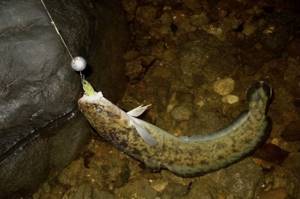
Fishing for burbot in mid- and late spring is not fundamentally different from fishing at the beginning of the season. It is important to understand here - the hotter the water warms up, the more passive the predator becomes and bites less often.
Good results are shown by bottom gear, especially the bait-and-dash bait, feeder and cargo. The first two methods are relevant at medium and long distances, the last method is suitable for close-range fishing along a flooded line or coastal edge.
Spinning is also suitable for hunting burbot. But you won’t be able to target just this predator. The method is universal and therefore more interesting than donka. When fishing with artificial baits, pike perch, perch, pike, catfish and asp are likely to bite.
We opened for burbot on Klyazma.

The constant demand for authorization here has bothered me. We need to find out why it doesn't remember passwords.
From 13 to 14 we opened for burbot on Klyazma with Sanya Malyaev.
It must be said that the stereotypes that have developed over the years have been destroyed. There is burbot, a lot of it. But he, a scoundrel, is capricious, like a crucian carp in the middle of summer - he won’t be bothered by this, he won’t be bothered by this, he’ll come up, try and leave... And meanwhile, while it was still light, he attacked a laurel tree that had landed on the picker and tried to swallow it... therefore the size is very good. He refused to take the worm. The cutting worked, and Sanka even had a sandwich with a cutting and a worm (holy shit... burbot and a sandwich???!!!))))) In short, a fish that, in my opinion, should, having found the bait, certainly bite itself sit down - she constantly came up, pinched, pulled the cutting... that is, she designated herself quite actively - but the result was more than modest. On the other hand, there are plenty of positives - Klyazma generally fascinates me every trip. I managed to get a lot of little things onto the light picker, I even caught a baby chub worth two hundred grams... but how did the picker swing? As an adult))) On a swing, at a baited point under the shore, the scoundrel pulled out four hundred grams... on a thin fishing line, such a pleasure and unexpected, moreover. I was trying so hard to catch the fry at night that it wasn’t a fish - it was either a horse-sized bleak or substandard sufferers. As a result, I drowned everything, a few bay leaves remained, so they went for cutting.
The whole place was somewhat spoiled... the place they chose was excellent, but you were sitting somewhat isolated, not in company. And in my conservative view of burbot, night fishing is a fire all night, sincere conversations, a stove with cooking, non-stop tea or coffee... well, they get pissed for being shot down... but without fanaticism.. and all this makes hunting for burbot like nothing else similar. It gives a certain charm. Therefore, every season, when others are hunting for a predator, I prepare for night hunts for freshwater cod. Although... the predator also doesn’t give rest... and the feeder hasn’t completely let go yet, it doesn’t feel like the feeder season is closed)))
So it goes from one to another... but it’s GREAT!!! For a long time I have no longer accepted devotion to any one type of fishing in particular, because fishing is so diverse, and, it seems to me, by giving ourselves entirely and completely to one thing, we miss out on a lot of amazing things in everything else.
It’s good that this season was rich and varied, with a float, bolo sabrefish, a feeder, a diverter, and wobblers... and now burbot hunting...
Good luck to everyone, friends!!!


